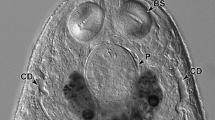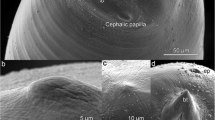Summary
The symbiont inhabited evaginations of the larval midgut of Lasioderma serricorne show the typical structure of insect midgut. It is a monolayer epithel composed of relatively few sterile cells with typical microvilli border and many mycetocytes. Their plasma is reduced and contains numerous symbiont cells, small, round or oval mitochondria and short tubules of the rough endoplasmic reticulum. Golgi complexes are scarce. The centrally located nucleus is indented following the contours of the symbiont cells. Towards the lumen a reduced microvilli border is present. The symbiont cells in the apical part are digested and expelled into the lumen, together with intact symbionts. The symbionts show the internal structure of typical yeasts, a vacuole occurs only in partly digested cells.
Zusammenfassung
Die symbiontenführenden Blindsäcke des Larvendarmes von Lasioderma serricorne zeigen den typischen Aufbau des Insekten-Mitteldarmes. Ein einschichtiges Epithel besteht aus relativ wenigen sterilen Zellen mit typischem Microvilli-Saum und zahlreichen Mycetocyten. Deren Plasma ist stark reduziert, es enthält zahlreiche Symbiontenzellen, kleine, runde oder ovale Mitochondrien und kurze Schläuche des rauhen endoplasmatischen Reticulums. Golgi-Komplexe sind selten. Der Kern liegt zentral; er weist zahlreiche Einbuchtungen auf, welche den Umrissen der Symbiontenzellen folgen. Zum Lumen hin besitzen die Mycetocyten einen stark reduzierten Saum von Microvilli. Die Symbionten werden im apikalen Teil der Mycetocyten angedaut und ins Blindsacklumen ausgestoßen, zusammen mit wenigen intakten Symbionten. Sie zeigen den Aufbau normaler Hefezellen; eine Vakuole tritt nur in angedauten Zellen auf.
Similar content being viewed by others
Literatur
Akai, H., Ito, T.: Note on the ultrastructure of midgut cells of germfree larvae of the silkworm, Bombyx mori, reared on semi-synthetic diet. Annot. Zool. Jap. 46, 183–187 (1973)
Breitsprecher, E.: Beiträge zur Kenntnis der Anobiidensymbiose. Z. Morph. Ökol. Tiere 11, 495–538 (1928)
Buchner, P.: Studien an intrazellulären Symbionten. III. Die Symbiose der Anobiiden mit Hefepilzen. Arch. Protistenk. 42, 320–331 (1921)
Buchner, P.: Endosymbiosis of animals with plant microorganisms. New York: Wiley 1965
Burgos, M. H., Gutiérrez, L. S.: The intestine of Triatoma infestans. 1. Cytology of the midgut. J. Ultrastruct. Res. 57, 1–9 (1976)
Chang, K. P.: Effects of elevated temperature on the mycetome and symbiotes of the bed bug Cimex lectularius (Heteroptera). J. Invert. Path. 23, 333–340 (1974)
Chang, K. P., Musgrave, A. J.: Multiple symbiosis in a leafhopper, Helochara communis Fitch (Cicadellidae: Homoptera): Envelopes, nucleoids and inclusions of the symbiotes. J. Cell Sci. 11, 275–293 (1972)
Davison, M. T., Garland, P. B.: Structure of mitochondria and vacuoles of Candida utilis and Schizosaccharomyces pombe studied by electron microscopy of serial thin sections and model building. J. gen. Microbiol. 98, 147–153 (1977)
Ehrhardt, P.: Magnesium und Calcium enthaltende Einschlußkörper in den Mitteldarmzellen von Aphiden. Experientia (Basel) 21, 337 (1965a)
Ehrhardt, P.: Speicherung anorganischer Substanzen in den Mitteldarmzellen von Aphis fabae Scop. und ihre Bedeutung für die Ernährung. Z. vergl. Physiol. 50, 293–312 (1965b)
Foeckler, F.: Reinfektionsversuche steriler Larven von Stegobium paniceum L. mit Fremdhefen. Z. Morph. Ökol. Tiere 50, 119–162 (1961)
Fraenkel, G., Blewett, M.: Intracellular symbionts of insects as sources of vitamins. Nature (Lond.) 152, 506 (1943a)
Fraenkel, G., Blewett, M.: The vitamin B-complex requirements of several insects. Biochem. J. 37, 686–692 (1943b)
Fraenkel, G., Blewett, M.: Biotin, B1, riboflavin, nicotinic acid, B6 and pantothenic acid as growth factors for insects. Nature (Lond.) 150, 117 (1942)
Franke, W. W., Krien, S., Brown, Jr., R. M.: Simultaneous glutaraldehyde-osmium tetroxide fixation with postosmication. Histochemie 19, 162–164 (1969)
Gartner, L. P.: Fine structure of adult Drosophila midgut musculature. J. Submicr. Cytol. 8, 131–136 (1976)
Gouranton, J.: Composition, structure, et mode de formation des concrétions minérales dans l'intestin moyen des Homoptères Cercopides. J. Cell Biol. 37, 316–328 (1968)
Graebner, K.-E.: Vergleichend morphologische und physiologische Studien an Anobiiden-und Cerambycidensymbionten. Z. Morph. Ökol. Tiere 42, 471–528 (1954)
Gresson, R. A. R., Threatgold, L. T.: An electron microscope study of bacteria in the oocytes and follicle cells of Blatta orientalis. Quart. J. micr. Sci. 101, 295–297 (1960)
Griffiths, G. W., Beck, S. D.: Ultrastructure of pea aphid mycetocytes: Evidence for symbiote secretion. Cell Tiss. Res. 159, 351–367 (1975)
Heinrich, D., Zebe, E.: Zur Feinstruktur der Mitteldarmzellen von Locusta migratoria in verschiedenen Phasen der Verdauung. Cytobiologie 7, 315–326 (1973)
Hereward, F. V.: A function for the plasmalemma grooves of a fission yeast. J. gen. Microbiol. 97, 161–167 (1976)
Jeantet, A.-Y., Martoja, R., Truchet, M.: Rôle des sphérocristaux de l'épithélium intestinal dans la résistance d'un insecte aux pollutions minérales: données expérimentales obtenues par utilization de la microsonde électronique et du micro-analyseur par émission ionique secondaire. C. R. Acad. Sci. (Paris) 278, 1441–1444 (1974)
Jurzitza, G.: Studien an der Symbiose der Anobiiden. II. Physiologische Studien am Symbionten von Lasioderma serricorne F. Arch. Mikrobiol. 49, 331–340 (1964)
Jurzitza, G.: Untersuchungen über die Wirkung sekundärer Pflanzeninhaltsstoffe auf die Pilzsymbiose des Tabakkäfers Lasioderma serricorne F. 2. Die Entwicklung normaler und aposymbiontischer Larven in Tabak mit verschiedenem Nikotingehalt. Z. angew. Entomol. 63, 233–236 (1969a)
Jurzitza, G.: Die Rolle der hefeartigen Symbionten von Lasioderma serricorne F. (Coleoptera, Anobiidae) im Proteinmetabolismus ihrer Wirte. 1. Das Wachstum normaler und aposymbiontischer Larven in Diäten mit Proteinen, Proteinderivaten und Aminosäuregemischen als N-Quellen. Z. vergl. Physiol. 63, 165–181 (1969b)
Jurzitza, G.: Der Vitaminbedarf normaler und aposymbiontischer Lasioderma serricorne F. (Coleoptera, Anobiidae) und die Bedeutung der symbiontischen Pilze als Vitaminquelle für ihre Wirte. Oecologia 3, 70–83 (1969c)
Jurzitza, G.: Aufzuchtversuche an Lasioderma serricorne F. in Drogen-und Holzpulvern im Hinblick auf die Rolle der hefeartigen Symbionten. Z. Naturforsch. 24b, 760–763 (1969d)
Jurzitza, G.: Über Isolierung, Kultur und Taxonomie einiger Anobiidensymbionten (Insecta, Coleoptera). Arch. Mikrobiol. 72, 203–222 (1970)
Jurzitza, G.: Über die Lieferung von Sterinen durch die hefeartigen Endosymbionten von Lasioderma serricorne F. (Coleoptera, Anobiidae) und die ökologische Bedeutung dieser Leistung für den Wirt. Oecologia 16, 163–172 (1974)
Jurzitza, G.: Die Aufzucht von Lasioderma serricorne F. in holzhaltigen Vitaminmangeldiäten. Ein Beitrag zur Bedeutung der Endosymbiosen holzzerstörender Insekten als Vitaminquellen für ihre Wirte. Material u. Organismen, Beiheft 3, 499–505 (1976)
Karawaiew, W.: Über Anatomie und Metamorphose des Darmkanals der Larve von Anobium paniceum. Biol. Zbl. 19, 122–130, 161–171, 196–220 (1899)
Kaspari, H.: Elektronenmikroskopische Untersuchung zur Feinstruktur der endotrophen Tabakmykorrhiza. Arch. Mikrobiol. 92, 201–207 (1973)
Koch, A.: Symbiose — Partnerschaft fürs Leben. Frankfurt: Suhrkamp 1976
Körner, H. K.: Zur Ultrastruktur der intracellulären Symbionten im Embryo der Kleinzikade Euscelis plebejus Fall. (Homoptera, Cicadina). Z. Zellforsch. 100, 466–473 (1969a)
Körner, H. K.: Entwicklung der Symbiontenorgane einer Kleinzikade (Euscelis plebejus Fall.) nach Ausschaltung der Symbionten. Experientia (Basel) 25, 767–768 (1969b)
Körner, H. K.: Die embryonale Entwicklung der symbiontenführenden Organe von Euscelis plebejus Fall. (Homoptera, Cicadina). Oecologia 2, 319–346 (1969c)
Körner, H. K.: Elektronenmikroskopische Untersuchungen am embryonalen Mycetom der Kleinzikade Euscelis plebejus Fall. (Homoptera, Cicadina). I. Die Feinstruktur der a-Symbionten. Z. Parasitenk. 40, 203–226 (1972)
Körner, H. K.: Elektronenmikroskopische Untersuchungen am embryonalen Mycetom der Kleinzikade Euscelis plebejus Fall. (Homoptera, Cicadina). II. Die Feinstruktur der t-Symbionten. Z. Parasitenk. 44, 149–164 (1974)
Körner, H. K.: On the host-symbiont-cycle of a leafhopper (Euscelis plebejus) endosymbiosis. Experientia (Basel) 32, 463–464 (1976)
Körner, H. K., Feldhege, A.: Einschlußkörper in symbiontischen Bakterien einer Kleinzikade (Euscelis plebejus Fall.). Cytobiologie 1, 203–207 (1970)
Körner, H. K., Sander, K.: Symbionten in der Embryonalentwicklung einer Zikade. Umschau 72/8, 254–255 (1972)
Lamparter, H. E.: Intrazelluläre symbiontische Bakterien im Zentralnervensystem der Ameise. Z. Zellforsch. 81, 1–11 (1967)
Lanham, U. N.: Observations on the supposed intracellular symbiotic microorganisms of aphids. Science 115, 459–460 (1952a)
Lanham, U. N.: Mitochondria or microorganisms? Science 116, 332–333 (1952b)
Louis, C.: Cytologie et cytochimie du mycétome de Pseudococcus maritimus (Ehrhorn) (Homoptera Coccidae). C. R. Acad. Sci. (Paris) 265, 437–440 (1967)
Malke, H., Bartsch, G.: Elektronenoptische Untersuchungen zur intrazellulären Bakteriensymbiose von Nauphoeta cinerea (Olivier) (Blattidae). Z. allg. Mikrobiol. 6, 163–176 (1966)
McLean, D.L., Houk, E. J.: Phase contrast and electron microscopy of the mycetocytes and symbiontes of the pea aphid, Acyrthosiphon pisum. J. Insect Physiol. 19, 625–633 (1973)
Meyer, G. F., Frank, W.: Elektronenmikroskopische Studien zur intrazellulären Symbiose verschiedener Insekten. I. Untersuchungen des Fettkörpers und der symbiontischen Bakterien der Küchenschabe (Blatta orientalis L.). Z. Zellforsch. 47, 29–42 (1957)
Milburn, N. S.: Fine structure of the pleomorphic bacteroids in the mycetocytes and ovaries of several genera of cockroaches. J. Insect Physiol. 12, 1245–1254 (1966)
Milne, D. L.: A study of the nutrition of the cigarette beetle Lasioderma serricorne F. (Coleoptera: Anobiidae) and a suggested new method for its control. J. Ent. Soc. S. Africa 26, 43–63 (1963)
Mollenhauer, H. H.: Plastic embedding mixtures for use in electron microscopy. Stain Technol. 39, 111–114 (1964)
Müller, W.: Untersuchungen über die Symbiose von Tieren mit Pilzen und Bakterien. Über die Pilzsymbiose holzfressender Insektenlarven. Arch. Mikrobiol. 5, 84–147 (1934)
Nardon, P.: Contribution à l'étude des symbiotes ovariens de Sitophilus sasakii: localisation, histochimie et ultrastructure chez la femelle adulte. C. R. Acad. Sci. (Paris) 272, 2975–2978 (1971)
Pant, N. C., Fraenkel, G.: The function of the symbiontic yeasts of two insect species, Lasioderma serricorne F., and Stegobium (Sitodrepa) paniceum L. Science 112, 498–500 (1950)
Pant, N. C., Fraenkel, G.: Studies on the symbiotic yeasts of two insect species, Lasioderma serricorne F., and Stegobium paniceum L. Biol. Bull. 107, 420–432 (1954)
Pell, P. E., Southern, D. I.: Symbionts in the female tsetse fly Glossina morsitans morsitans. Experientia (Basel) 31, 650–651 (1975)
Reinhardt, C., Hecker, H.: Structure and function of the basal lamina and the cell junctions in the midgut epithelium (stomach) of female Aedes aegypti L. (Insecta, Diptera). Acta trop. (Basel) 30, 213–236 (1973)
Reynolds, E. S.: The use of lead citrate at high pH as an electron-opaque stain in electron microscopy. J. Cell Biol. 17, 208–212 (1963)
Schwemmler, W.: Intracellular symbionts: a new type of primitive prokaryotes. Cytobiologie 3, 427–429 (1971)
Schwemmler, W.: Studies on the fine structure of leafhopper intracellular symbionts during their reproductive cycles (Hemiptera: Deltocephalidae). Appl. Ent. Zool. 9, 215–224 (1974)
Strugger, S.: Fluoreszenzmikroskopie und Mikrobiologie. Hannover: Schaper 1949
Van der Walt, J. P.: The mycetome symbiont of Lasioderma serricorne. Antonie v. Leeuwenhoek 27, 362–366 (1961)
Waku, Y., Sumimoto, K. I.: Metamorphosis of midgut epithelial cells in the silkworm (Bombyx mori L.) with special regard to the calcium salt deposits in the cytoplasm. II. Electron microscopy. Tissue et Cell 6, 127–136 (1974)
Author information
Authors and Affiliations
Additional information
Mit Unterstützung durch die Deutsche Forschungsgemeinschaft
Rights and permissions
About this article
Cite this article
Jurzitza, G. Elektronenmikroskopische Untersuchungen an den symbiontenführenden Mitteldarm-Blindsäcken der Larve von Lasioderma serricorne F. (Coleoptera, Anobiidae). Z. Parasitenk. 54, 193–207 (1977). https://doi.org/10.1007/BF00380802
Received:
Issue Date:
DOI: https://doi.org/10.1007/BF00380802




